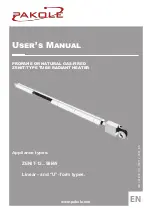
RUNNING THE FEED & RETURN LINES FROM THE ROOF TO GROUND LEVEL.
-
23
12. Running the Feed & Return Lines
From Roof to Ground Level.
1.
2.
3.
4.
5.
6.
7.
8.
Cement the appropriate size CPVC 90-degree elbow to the return line stub facing down toward the bottom header.
Repeat the process for the feed line header stub and face the elbow down away from the array. (see Fig. 12.1, page
24).
Determine where the feed and return pipe will go over the edge of the roof. If possible, this should be perpendicular
to the exact points where they will fasten into the existing system or into pipes coming from another location (see
Fig. 13.1, page. 24).
Measure the distance from the return elbow down to the spot that you want to go, across the roof, to the point
established above.
Be sure to include the depth of the socket in the elbow in your measurement.
Cut a piece of
PVC pipe to this length. Repeat this process for the feed line.
If you are not experienced at cutting and fitting pipe, it is a good idea to assemble all pipe and fittings before
cementing them just in case you make an error. Clean the burrs off of these cut pipe lengths and insert them into the
elbows.
Measure across the roof from these pipes to the points established in Step 3. Cut and de-burr pipes to these lengths
and assemble corner with 90-degree elbows.
Continue this process around the edge of the roof and down to the existing plumbing, keeping pipes as short, straight,
and tight to the building as possible.
Once you are satisfied with the plumbing arrangement, go back and cement all of your joints together using the
good plumbing techniques explained in the “Getting Started” section.
Secure long pipe runs with C-clamps or G-clamps one size larger than the pipe diameter using (1-5060-011) 1/4” x 4”
stainless steel lag bolts and polyurethane caulk. Secure vertical pipe runs on the side of buildings with pipe-clamps
the same size as the pipe diameter using screws and anchors as needed.
Here is the standard, most straight-forward way of running the CPVC/PVC pipe from the feed and return lines to the
equipment pad. Some installations require a more creative approach due to unique roof designs or equipment pad
locations. Whenever possible, the return line should have the shortest run and all pipes should run without traps to
allow for automatic drain-down of the plumbing and solar array. If this is not possible, manual drain valves should be
installed as needed.
If your equipment pad is against your house, you may want to complete the necessary plumbing at the equipment pad
before completing this portion of the installation. This allows you to know exactly where the pipe should come down
from the roof. This is not necessary if you will be trenching from the equipment pad to the installation location.
NOTE:
Whenever cementing, lay a rag on the roof or rack under the joint to avoid dripping cement on the
mounting surface. Also, it is a good idea to tape the cans of CPVC/PVC cleaner and CPVC/PVC cement together;
they are less likely to tip over and spill this way.
INSTALLATION MANUAL eco-SPARK™ SOLAR POOL HEATER
©
2015 UMA Solar















































